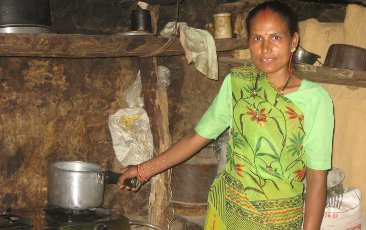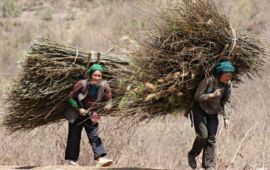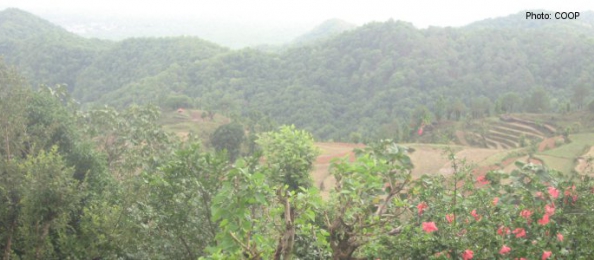Top-flight Compensation Projects: The Climate, People, and Animals All Benefit
Offsetting CO2 emissions is a good thing – but there is still a hint of a “sale of indulgences.” Coop has found a solution: The Swiss retailer only invests in development projects that are either developed by the WWF according to the Gold Standard or which are supported by the WWF. They stand for maximum quality.
Khasti Devi, a farmer from the village of Mankanthpur in northern India, is happy. She has a new kitchen. But she is not pleased because she has conveniences such as a dishwasher, refrigerator, and steamer. Khasti has a new oven that runs on biogas instead of wood. The family uses a new biogas plant to produce the biogas from the manure of its two cows. This was not cheap: The family contributed 40 percent of the total cost of around 400 Swiss francs. They had to spend 17 francs on a compost site. The rest of the money – amounting to just over 200 francs – comes from carbon-offsetting compensation from Coop.
| Initiator | Coop |
| Project start | 2012 |
| Status | ongoing |
| Region | Worldwide |
| Contact person | Thomas Compagno |
| Awards | - |
Project benefit
- Fight against Climate Change
- Reduce CO2-Emissions
- Strengthen local communities
| Anti-Corruption | - |
| Business & Peace | - |
| Development | - |
| Environment | X |
| Financial Markets | - |
| Implementing UNGC Principles in your Corporate CSR Management | - |
| Human Rights | - |
| Labour Standards | - |
| Local Networks | - |
| Advocacy of global issues | - |
| Business opportunities in low income communities/countries | - |
| Project funding | X |
| Provision of goods | - |
| Provision of services/personal | - |
| Standards and guidelines development | - |
The retailer uses biogas plants such as this to offset part of the emissions caused by flying-in fresh produce. Coop and the WWF intend to build several thousand biogas plants in India. The WWF has already successfully implemented similar projects for Coop in Nepal. This helps families and the climate, as a family uses around 25 kg of wood for fuel each day. The forest – as a valuable CO2 storage facility – is also protected. The Devi family alone has reduced its CO2 emissions by around four tons per year, thanks to the biogas plant. This corresponds to the average annual output of a car, that is, around 15,000 km traveled.
The small village of Mankanthpur, where Khasti lives, is in northern India, half an hour to the east of the Corbett National Park in the Terai region. The fertile 800 km-long valley stretches along the south of the Himalayas in India, Nepal, and Bhutan. In this region, many people still rely on wood as their main fuel. The pressure on the forests is therefore huge. But the Terai region also has the world’s highest density of tigers. It is estimated that there are around 16 animals per 100 sq km. But because their habitat is being reduced as a result of deforestation for agriculture, settlements, and fuel, conflicts are inevitable. At least for Khasti, these are now a thing of the past.

Thanks to the biogas plant, the family’s safety and health has improved. “The kitchen and all the pans used to be black with soot, the air in the house was permanently smoky,” she says. Everyone used to suffer from tears in their eyes and chronic coughs. Smoke in living quarters is one of the most frequent causes of death in many developing countries – almost half the world’s population still cooks on an open fire or with primitive stoves. According to the organization Global Alliance for Clean Cookstoves, a person dies from the consequences of this toxicity every 16 seconds. Today, the walls in Khasti’s house are bright, and the air is clean. “And cooking is much easier,” she says while pouring tea for her guests. It takes just a few minutes to heat the water on the new gas stove.
Devi says that it’s easy to use the biogas plant. She places 25 kg of manure and about the same quantity of water into the fermenter. Fermentation produces methane gas in the tank, which can be used for cooking. The residue is ejected by pressure in the tank. This is a valuable, non-odorous fertilizer. Producing plants like this so that people no longer have to deal with dangerous conditions is one of the goals of the WWF in the Terai region of India. But it is far from the only one. “If conflicts between people and animals can be avoided, nature also benefits,” says K.D. Kandpal, a representative of the WWF in India. One of the WWF’s goals is to double the tiger population worldwide in the next 10 years: 100 years ago, the world’s tiger population was put at around 100,000; they now number around 4,000, of which 1,700 live in India. But tigers need space. Depending on the availability of prey, a tiger’s territory can stretch over 30–50 sq km. “If fewer people enter the forest, that’s better for the tiger,” says Kandpal.
For Khasti Devi and her family, the facility is certainly a blessing. Now that she no longer needs to enter the forest she has time for other things. “Now I have more time to work our land, and look after the children and the house.” Her smiling face shows that her life really has improved.

Coop: Offsetting Projects Are Better Than Their Image
There are two main points that have to be fulfilled for Coop in order to reach the maximum level with its CO2 offsetting projects: Firstly, the projects have to be recognized development projects and, if possible, related to the supply chain for Coop’s products – and they should help those people most affected by climate change. This often means the small-scale farmers who do not have the resources to deal with the consequences. Specifically, the projects are developed by the WWF and correspond to the global Gold Standard. In a statement, the WWF explains that this standard imposes strict conditions in terms of sustainability and sets the highest ethical requirements. Overall, Coop offset more than 80,000 tons of CO2 equivalent in accordance with the strictest standards in 2012. Examples follow:
- In Madagascar, open fires are being replaced with solar-powered stoves. This helps to counter deforestation of rainforests and other forests. There are 13,000 solar-powered and low-energy stoves per year that are replacing 7,800 tons of wood. Each stove saves 2–3 tons of CO2 per year.
- In Kenya’s Lake Naivasha region, open fires are being replaced with more efficient stoves. This also works to counter deforestation and also relieves people of the need to gather wood, which requires them to walk for long distances. In addition, it reduces the effects of smoke inside their houses.
- In southern China, new and highly efficient stoves are replacing conventional cookers. The new stoves result in about half the quantity of wood being saved, with 1,600 stoves eliminating 16,000 tons of CO2. The quality of air in the houses also improves.
- In the Terai region of Nepal, people are relying on biogas plants. The technology is simple and reliable. Fermentation of manure produces heat for cooking and valuable fertilizer.
- Biogas facilities are also being built in the Terai region of India. They reduce pressure on forests, as people no longer need to gather wood for fuel. There are thus fewer conflicts between people and tigers. The negative effects of smoke in houses can be virtually eliminated.
This project description was originally presented in the Global Compact International Yearbook 2013.
Thomas Compagno is an employee of COOP.
About Coop
Coop, a Swiss cooperative, is the second largest retailer after the Migros in Switzerland. In 2001, Coop merged with 11 cooperative federations which had been its main suppliers for over 100 years. As of 2007, Coop operates 1437 shops and employs almost 48 200 people. According to Bio Suisse, the Swiss organic producers' association, Coop accounts for half of all the organic food sold in Switzerland. Coop's four primary organic brands are Coop Oecoplan, Coop Naturaline, Coop Naturaplan, and Max Havelaar.
Coop also has a low-cost product line, "Prix Garantie." Other than that, the latest product line from Coop is entitled PlanB and focuses on young clients looking for food on the go.
The chain has an online presence called coop@home. The web site offers much of the same selection found in the Coop stores and delivers groceries, wine, flowers, books, and other products to customers in Switzerland and Lichtenstein. It currently markets its services in German, French, and English.
Coop and Sustainability
Sustainability is an integral part of the Coop Group's business
activities and a cornerstone of its long-term success. Coop has
therefore incorporated sustainability into its Articles of Association,
Corporate Profile and Mission Statement. It translates this
responsibility into practice in its everyday operations and focuses on
strong, long-term partnerships and joint solutions.
Its annual Sustainability Report provides transparent information on Coop's ecological and social-accountability activities, its goals and the measures it takes to achieve them.
Coop coordinates all its sustainability-related activities through the Sustainability Steering Committee, on which all the business units and departments concerned are represented. This body directs projects dealing with sustainable sourcing and corporate ecology and checks the extent to which they achieve their goals. It also sets priorities for implementation and communication.
Wherever possible, Coop seeks
to integrate sustainability into its standard procedures and processes.
It also incorporates the sustainability goals into its individual
strategies. Hence, line management is responsible for implementing
sustainability-related measures. It is supported by a small team of
specialists responsible for clarifying issues, providing advice,
organizing in-house training and coordinating projects.
Two
interdepartmental committees for food and non-food respectively define
general questions concerning standards, priorities and any corrective
measures to be taken. The actual work of coordinating sustainable
sourcing is done in small, project-related working groups.
At the
corporate-ecology level, Coop has set up two centres of excellence: one
focuses on manufacturing companies, distribution centres and logistics,
the other on the total of over 1,600 points of sale.
Products
Coop operates a wide range of store formats in the food, non-food and service sector.
Source: coop/wikipedia
Write a comment about this page
Your comments are provided by your own free will and you take sole responsibility for any direct or indirect liability. In order to maintain the highest discussion quality, all comments will be reviewed by our editors. You hereby provide us with an irrevocable, unlimited, and global license for no consideration to use, reuse, delete or publish comments in accordance with our Community Guidelines.
About Us // Privacy Policy // Copyright Information // Legal Disclaimer // Contact
Copyright © 2012-2018 macondo publishing GmbH. All rights reserved.
The CSR Academy is an independent learning platform of the macondo publishing group.









